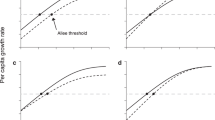Abstract
Many investigators demonstrate the existence of intra- and interspecific interactions through rigorous statistical hypothesis testing. Statistical significance of an interaction, however, does not necessarily imply that it controls a species population size or distribution. Other analytical methods must be used to make these important determinations. This paper demonstrates one method, with an example, to quantify the demographic importance of statistically significant interactions. In our example, some of the statistically significant interactions with the polychaete Clymenella torquata (Leidy) have large impacts on the population growth rate of the bivalve Gemma gemma (Totten), while others do not. This demonstrates the necessity of distinguishing between statistical significance and demographic importance. In some cases, the demographic importance of the same interaction changes through time because of changes in the bivalve's life history. Interactions affecting juvenile bivalves often have a greater demographic importance than those affecting adults; but this is not always the case.
Similar content being viewed by others
Literature cited
Andrewartha, H. G. and L. C. Birch: The distribution and abundance of animals, 782 pp. Chicago: University of Chicago Press 1954
Bradley, W. H. and P. Cooke: Living and ancient populations of the clam Gemma gemma in a Maine Coast tidal flat. U.S. Fish. Wildl. Serv., Fish. Bull. 58, 305–334 (1959)
Caswell, H.: A general formula for the sensitivity of population growth rate to changes in life history parameters. Theor. Pop. Biol. 14, 215–230 (1978)
Caswell, H., R. J. Naiman and R. Morin: Evaluating the consequences of reproduction in complex salmonid life cycles. Aquaculture 43, 123–134 (1984)
Colwell, R. K.: Predictability, constancy, and contingency of periodic phenomena. Ecology 55, 1148–1153 (1974)
DeKroon, H., A. Plaisier, J. van Groenendael and H. Caswell: Elasticity as a measure of the relative contribution of demographic parameters to population growth rate. Ecology (in press)
Dobbs, F. C.: Community ecology of a shallow subtidal sandflat, with emphasis on sediment reworking by Clymenella torquata (Polychaeta: Maldanidae). M. S. thesis, 145 pp. Storrs: University of Connecticut 1981
Dobbs, F. C. and R. B. Whitlatch: Aspects of deposit-feeding by the polychaete Clymenella torquata. Ophelia 21, 159–166 (1982)
Gentile, J. H., S. M. Gentile, N. G. Hairston, Jr. and B. K. Sullivan: The use of life tables for evaluating the chronic toxicity of pollutants to Mysidopsis bahia. Hydrobiol. 93, 179–187 (1982)
Green, R. H. and K. D. Hobson: Spatial and temporal variation in a temperate intertidal community, with special emphasis on Gemma gemma (Pelecypoda: Mollusca). Ecology 51, 999–1011 (1970)
Mangum, C. P.: Activity patterns in metabolism and ecology of polychaetes. Comp. Biochem. Physiol. 11, 239–256 (1964)
Rhoads, D. C. and D. J. Stanley: Biogenic graded bedding. J. Sed. Petrol. 35, 956–963 (1965)
Sanders, H. L., E. M. Goudsmit, E. L. Mills and G. E. Hampson: A study of the intertidal fauna of Barnstable Harbor, Massachusetts. Limnol. Oceanogr. 7, 63–79 (1962)
Sellmer, G. P.: Functional morphology and ecological life history of the gem clam Gemma gemma (Eulamellibranchia: Veneridae). Malacologia 5, 137–223 (1967)
Weinberg, J. R.: Population ecology of the marine bivalve Gemma gemma in relation to its infaunal community. Ph.D. thesis, 121 pp. Storrs: University of Connecticut 1983
Weinberg, J. R.: Interactions between functional groups in softsubstrata: do species differences matter? J. exp. mar. Biol. Ecol. 80, 11–28 (1984)
Weinberg, J. R.: Factors regulating population dynamics of the marine bivalve Gemma gemma: intraspecific competition and salinity. Mar. Biol. 75, 173–182 (1985)
Weinberg, J. R. and R. B. Whitlatch: Enhanced growth of a filter-feeding bivalve by a deposit-feeding polychaete by means of nutrient regeneration. J. mar. Res. 41, 557–569 (1983)
Author information
Authors and Affiliations
Additional information
Communicated by J. M. Shick, Orono
Rights and permissions
About this article
Cite this article
Weinberg, J.R., Caswell, H. & Whitlatch, R.B. Demographic importance of ecological interactions: how much do statistics tell us?. Mar. Biol. 93, 305–310 (1986). https://doi.org/10.1007/BF00508268
Accepted:
Issue Date:
DOI: https://doi.org/10.1007/BF00508268




